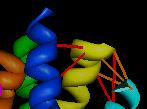

 Pseudobonds
are lines drawn between atoms to signify connections other than standard bonds.
PBReader allows users to define pseudobonds
connecting arbitrary pairs of atoms.
Pseudobonds
are lines drawn between atoms to signify connections other than standard bonds.
PBReader allows users to define pseudobonds
connecting arbitrary pairs of atoms.
PBReader is an extension in the Utilities category. There are several ways to start an extension.
Starting PBReader opens a dialog box. The only required input is the name of a file to read, which the user should have generated previously. This file lists pairs of atoms to be connected by pseudobonds, plus (optionally) colors and labels for the pseudobonds. The file may contain any number of lines of the form:
atom1 atom2 [color [label_text]]where atom1 and atom2 are atom specifications narrow enough to identify one atom each (usually of the form #model:res@atom) and square brackets enclose optional fields. Fields are separated by spaces, except that label_text can contain any number of spaces. If a label is desired, a color must also be specified. Colors can be specified by name or by Tk color code (for example, shown in the Color Name section of the Color Editor). Examples of suitable input lines:
#0:1@ca #0:2@ca blue this is a blue line
#0:3@n #0:4@o #55ff88 a Tk code
#0:5@n #1:6@n red
:7@ca :8@ca
No additional input is required, but the user may specify a name for the group of pseudobonds and default model numbers for the first and second atoms in each line of input. Pseudobonds specified in the same input file are all placed into a single group. Groups are treated collectively in terms of their properties, so if different types of display are desired for various pseudobonds, they should be created using separate input files. If no group name is specified, the name of the input file is used. If pseudobonds with the same group name already exist, the new pseudobonds can either be added to the group or used to replace its previous members (if Clear group... is set to true). The default model numbers are used when a model number is not included in a line of input (see the last line in the example above).
Pseudobond group display and attributes (such as linewidth and line type) can be controlled with the Pseudobond Panel.